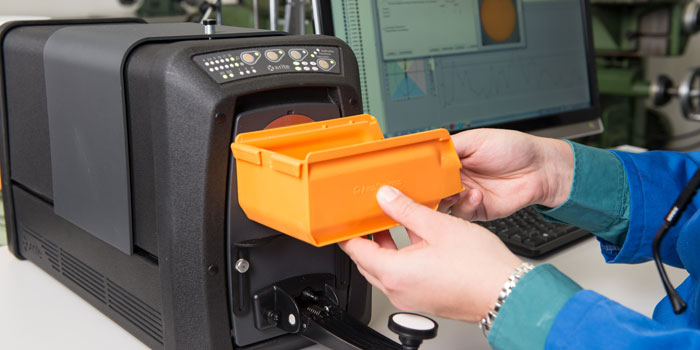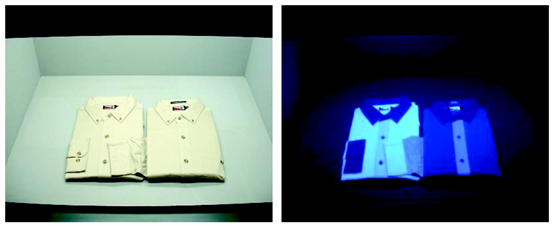Per definire un valido programma di controllo qualità sono necessari buoni strumenti, software validi e utenti esperti. Anche in presenza di tutti questi elementi, però, bisogna prestare attenzione ad alcune insidie piuttosto comuni quando si utilizza uno spettrofotometro per analizzare la qualità del colore.
Le cinque principali insidie della misurazione del colore
1. Campioni e standard sbagliati
Gli standard e i campioni fisici non sono eterni. La mancanza di attenzione nella loro manipolazione e la presenza di sporcizia nei dispositivi possono distruggerli rapidamente. Ecco tre suggerimenti per evitare i campioni sbagliati:
- Quando si crea uno standard fisico, acquisire più campioni dello stesso lotto e verificare che abbiano la stessa tonalità. Se si danneggia uno standard di lavoro, dovrai semplicemente gettarlo e sostituirlo con uno di riserva.
- Standardizzare, documentare e comunicare le procedure di preparazione dei campioni a tutte le parti coinvolte nel workflow per garantire che ogni operazione sia sempre eseguita allo stesso modo, da tutti.
- Tieni sempre puliti i campioni. Polvere, grasso e impronte digitali possono provocare l’imprecisione dei dati della misurazione. La nostra guida per proteggere i campioni fisici riporta suggerimenti per la conservazione di campioni e standard.
- Aumenta la durata dei tuoi standard conservandoli in un luogo fresco e buio, tenuti in buste di plastica nera (senza plastificanti) o in buste di carta non acide. Anche frigoriferi e congelatori aumentano la durata dei campioni.
2. Sbiancanti ottici
Non sempre il bianco è ciò che sembra. Questo effetto è causato dalla presenza di sbiancanti ottici, ossia sostanze fluorescenti aggiunte dai produttori per dare agli articoli un aspetto più bianco
Qui, per esempio, abbiamo due camicie bianche. Alla luce del giorno, i tessuti sembrano identici ma se visualizzati con luce UV si vede chiaramente la notevole differenza dei bianchi. Questo può essere un autentico problema per i produttori che realizzano articoli con parti prodotte in stabilimenti diversi. Nel nostro esempio, è ovvio che queste camicie sono state cucite con tessuti di fornitori diversi.
Ecco tre suggerimenti per controllare gli sbiancanti ottici:
- Utilizzare una cabina d’illuminazione per ispezionare le materie prime in varie condizioni d'illuminazione, così da rilevare un’eventuale problematica prima di avviare la produzione o l’assemblaggio.
- Utilizzare la cabina per ispezionare anche i prodotti finiti. È sempre più vantaggioso riscontrare una problematica in questa fase che dopo la spedizione.
- Utilizzare uno spettrofotometro capace di acquisire misurazioni UV. Lo spettrofotometro portatile Ci64 offre dimensioni di apertura flessibili e l’opzione di aggiungere l’illuminazione LED UV per acquisire misurazioni accurate del colore di materie plastiche, tessili e carte contenenti sbiancanti ottici.
Gli sbiancanti ottici non rappresentano un problema solo per i prodotti tessili, perché possono trovarsi anche in materiali come carta, imballaggi, plastica, vernici, rivestimenti e liquidi. Leggi il nostro blog OBA per saperne di più.
3. Metamerismo
Questo è lo Yankee Stadium. Come sono riusciti gli addetti al prato a far crescere l’erba in due colori differenti? Hanno sparso con attenzione due diversi tipi di semi, uno verde chiaro e l’altro verde scuro?
In questo caso, è vero che l’erba è più verde sull’altro lato. Letteralmente. Se costringi l’erba a orientarsi in una direzione, si vedrà di più il lato del filo. Se invece orienti l’erba in un’altra direzione si vedrà di più l’altra parte. Questo fenomeno è denominato gonioapparenza, o metamerismo geometrico.
La gonioapparenza si riscontra di frequente nei tessuti, in particolare pile, velluto e satin. Spazzolando il tessuto in una direzione si vede un colore. Spazzolandolo in un’altra direzione si vede un’altra tonalità. Come puoi ben immaginare, le superfici testurizzate sono difficili da misurare. Uno spettrofotometro a sfera come lo strumento da banco di X-Rite Ci7800 può misurare la luce riflessa a ogni angolazione e calcolare le misurazioni cromatiche che meglio corrispondono alla percezione dell’occhio umano.
4. TUtilizzo di uno spettrofotometro non adatto
Per scegliere il dispositivo di misurazione del colore più adatto bisogna tener conto delle caratteristiche dei campioni specifici. Non è possibile elencare tutte le variabili dei campioni in grado di influire sui dati delle misurazioni; tuttavia ne indichiamo alcune da prendere in considerazione:
- Il tuo campione è opaco o traslucido? Questo blog spiega come effettuare la scelta tra uno spettrofotometro per riflettanza e uno per trasmissione.
- l tuo campione è asciutto o umido? Gli articoli umidi appaiono in genere più scuri, e questo può alterare la misurazione. I campioni umidi possono inoltre contaminare l’ottica dello strumento e pregiudicare le future misurazioni. Questo blog riporta suggerimenti per misurare campioni umidi.
- Qual è la temperatura del tuo campione? Molti pigmenti sono termocromatici, vale a dire che i campioni cambiano effettivamente colore man mano che si scaldano. Pensiamo per esempio a come cambia il colore di una camicia quando viene stirata. A volte, la sezione calda asciutta appare meno cromatica finché non si raffredda e ritrova un po’ di umidità. Il nostro post sul termocromatismo spiega in che modo la temperatura influisce sulle misurazioni del colore.
5. Mancanza di procedure operative
Una volta individuato il massimo numero possibile di variabili, occorre definire le relative procedure. In questo modo, tutte le parti coinvolte nel programma di qualità del colore, in loco o in altre sedi, potranno controllare il colore in tutte le fasi di un ciclo di produzione.
- Redigere un elenco dettagliato di ogni possibile scenario.
- Creare procedure che tutti dovranno rispettare quando si misurano i campioni.
- Condividerle con tutte le persone coinvolte nel processo di produzione del colore.
In caso contrario, i dati saranno ambigui e sarà più difficile controllare il colore.
Evitare le insidie della misurazione del colore
ESe si tiene conto di queste insidie durante la definizione delle procedure di misurazione e gestione del colore, si avranno più probabilità di ottenere un colore accurato.
Stai affrontando un altro tipo di insidia? Contattaci e i nostri esperti del colore ti aiuteranno a risolvere il problema.



